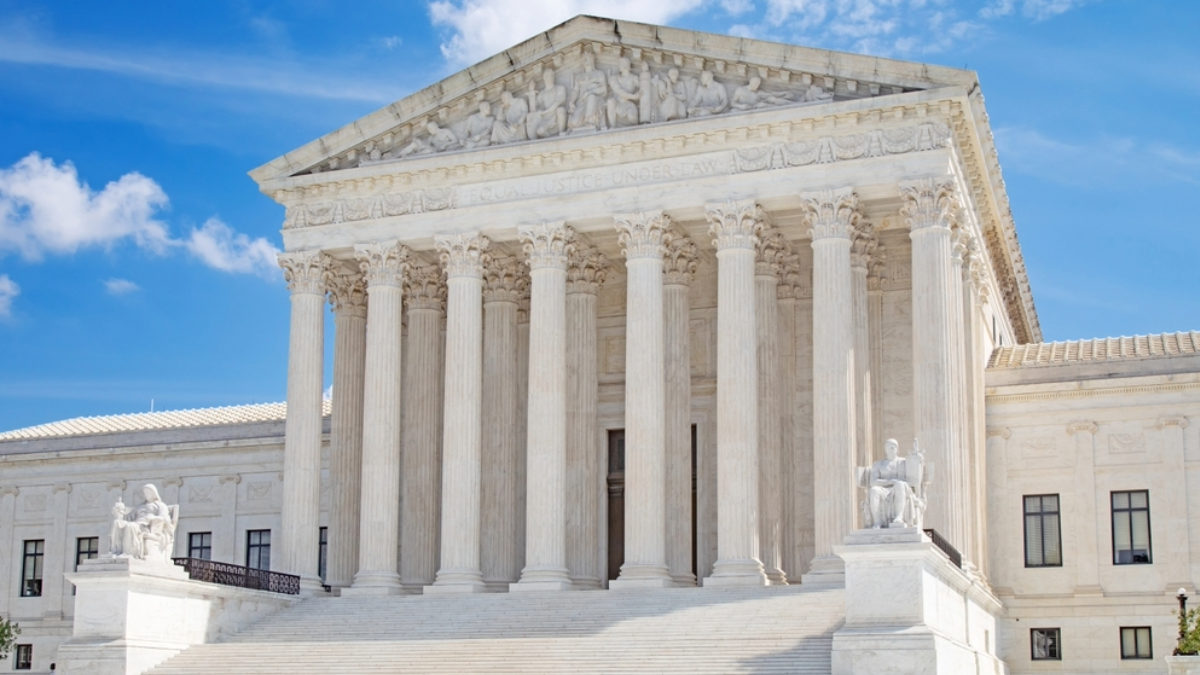How Free Speech Coalition v. Paxton Will Change Tech Policy
Jasmine Mithani / Jul 10, 2025Jasmine Mithani is a fellow at Tech Policy Press.

The US Supreme Court. Shutterstock
The Supreme Court last month weighed in on online age verification for the first time in two decades, reversing long-held precedent to uphold the constitutionality of a Texas law requiring websites to block minors from accessing pornography websites. Under the law, sites must verify ages with government identification, biometric data or equivalent information.
Policymakers and advocates were closely watching the case, Free Speech Coalition et al. v. Paxton, to see how a decision would impact states’ ability to restrict First Amendment rights online in order to shield children from obscene content. The ruling also has major implications for the future of age verification, as advocates fight over the most effective way to prevent minors from engaging with sexually explicit or otherwise harmful material.
The majority opinion, written by Justice Clarence Thomas, ruled that Texas’s H.B. 1811 primarily regulated “unprotected activity” and only “incidentally” burdened protected speech, triggering intermediate scrutiny — the legal test in between rational basis, which the U.S. Court of Appeals for the Fifth Circuit used, and strict scrutiny, which a district court in Texas had applied.
Twenty-four states have passed similar age verification laws since Louisiana first kicked off the trend in 2022, according to the Free Speech Coalition, the adult industry trade association who sued Texas. Consequences for failing to implement age-checks vary across state laws, but commonly include steep fines. Companies violating Texas’s law can rack up $10,000 per day in fines for failing to comply.
Several legal challenges to other state age verification laws were put on hold in anticipation of the Supreme Court’s ruling, but those are now moving forward, likely siding with states. That’s just one of the major ripple effects of the court’s landmark ruling.
Creating a more friendly environment for age verification
The Supreme Court has repeatedly ruled against age verification online in the past, including most recently in Ashcroft v. American Civil Liberties Union (ACLU) in 2004. This decision, in addition to the earlier Reno v. ACLU ruling striking down much of the Communications Decency Act, has long been a roadblock to implementing rigorous age verification online.
“We expect the opinion will change the conversation about what is technically possible,” said Ariel Fox Johnson, senior adviser for Common Sense Media, an advocacy group that lobbies for child safety measures.
“Just as we have created safeguards in the physical world — we keep certain spaces only for adults, or require additional safety guidelines and testing for children’s products — we need those protections for children in the digital world too,” she said.
Texas Attorney General Ken Paxton (R) celebrated the ruling in a statement: “Companies have no right to expose children to pornography and must institute reasonable age verification measures.” He vowed to continue to prosecute companies in violation of the law. His office did not respond to a request for comment.
“Today’s decision gives all of us confidence to keep moving forward,” Louisiana State Rep. Laurie Schlegel (R), the author of the first state age verification law, wrote on X.
Tom McBrien, counsel at the Electronic Privacy Information Center (EPIC) advocacy group, said the decision will help refute “industry contentions that child privacy and safety legislation is unconstitutional merely because it incorporates age assurance requirements.”
But privacy watchdogs aren’t keen on how this opinion clears the way for age verification writ large. Aaron Mackey, free speech and transparency litigation director at the Electronic Frontier Foundation, said the Supreme Court’s decision will encourage “age verification for a broad variety of adult sites, creating a privacy and data security nightmare for users of all ages.”
Side-stepping privacy concerns
EPIC’s McBrien said that by and large, the court “ignored the salience of online privacy in its First Amendment analysis.” By equating websites imposing age verification measures with brick-and-mortar sex shops requiring customers to flash their identification, the majority opinion dismissed privacy concerns unique to the digital age.
The majority opinion did acknowledge the sweeping changes to the internet made since the court’s 2004 ruling on the Child Online Protection Act, the law at the center of the Ashcroft v. ACLU case. Thomas discussed the ubiquity of online content available through smartphones and laptops, giving adolescents “massive libraries of pornographic videos” at their fingertips.
At the same time, the opinion did not engage with many of the added privacy risks of life online. During oral arguments, Justice Samuel Alito quickly dispatched concerns about age verification vendors getting hacked, exposing user data collected for the purposes of age-gating. “There have been hacks of everything,” he replied. The majority opinion characterized online age verification as a “modest burden,” and asserted vendors “have every incentive to assure users of their privacy.”
In her dissent in the Free Speech Coalition case, Justice Elena Kagan highlighted how users face a privacy quandary when asked to verify their ages by supplying their government ID or biometric information to websites.
“It is turning over information about yourself and your viewing habits—respecting speech many find repulsive—to a website operator, and then to…who knows? The operator might sell the information; the operator might be hacked or subpoenaed,” she wrote.
Kagan sided with petitioners in arguing that strict scrutiny should be applied to evaluate whether H.B. 1811 uses the “least restrictive means” to achieve its goals.
She pushed back against the majority’s argument that this case is different from Reno or Ashcroft. “Texas’s law defines speech by content and tells people entitled to view that speech that they must incur a cost to do so,” Kagan wrote. “That is, under our First Amendment law, a direct (not incidental) regulation of speech based on its content—which demands strict scrutiny.”
Downstream effects on First Amendment cases
While no one knows exactly how the ruling will reverberate, it “certainly lowers the bar for legislators looking to regulate speech on the Internet,” said Mandy Salley, chief operating officer at Woodhull Freedom Foundation, a sexual rights nonprofit active on cases involving free speech online.
Since the Supreme Court opted against applying strict scrutiny in the case, they ultimately didn’t contend with other aspects of the law, including which companies and websites the law should apply to. Under the law, the age verification mandate only applies to websites containing at least one-third content “harmful to minors,” defined exclusively as sexually explicit content. But the language leaves some questions up to interpretation, including how that figure is calculated — is it the proportion of media uploaded to a site, or the individual pages on it?
Samir Jain, vice president of policy at the Center for Democracy and Technology non-profit, said he worried about a future in which those thresholds are increasingly lowered. Kansas’s age verification law, for example, applies to sites with 25 percent adult content, as opposed to 33 percent.
Some states are dispensing with these designations altogether.
Mike Stabile, the director of public policy at the Free Speech Coalition, noted that South Dakota’s age verification law, which went into effect July 1, applies to all websites “for which it is in the regular course of trade or business to create, host, or make available material harmful to minors,” regardless of how much of their content is sexually explicit. This implicates social media sites too, he said, which otherwise could have avoided these laws.
Stabile sees this as the beginning of a trend of conservative legislators regulating content “harmful to minors” across a broad swatch of mediums.
Jain said these laws could also be co-opted to restrict content about LGBTQ+ people or reproductive health, including by designating it as “obscene for minors,” though he thinks the opinion should only apply to content illegal for minors to access..
The ramifications of this decision are not limited to tech policy, according to Kendra Albert, partner at the public interest technology and media law firm Albert Sellars LLP.
While the level of scrutiny required in content-based regulations was previously straightforward, they said, “now it feels a lot more like there's wiggle room for drawing different conclusions in different circumstances."
Many legislative attempts to rein in more concrete harms, like privacy protections or bans on consensual intimate imagery, have historically struggled to circumvent First Amendment challenges, Albert said. But in a case about legal sexual content and child protection, those First Amendment concerns were side-stepped.
In some ways, this decision could make it more difficult to challenge speech regulations, Albert said. They also addressed worst-case concerns about how the ruling could be instantly weaponized.
“Obscenity is a defined legal term,” Albert said, and applies in the context of sexually explicit content. And while there are certainly forces on the right who want to redefine LGBTQ+ existence as obscene, “one needs to balance that a little bit with the fact that there is actually a long historical tradition of First Amendment engagement with obscenity in particular, and with minors access to obscenity, that is quite a bit different.”
In other words, lawmakers can’t now unilaterally label any content they disapprove of as “obscene” and thus subject to regulation. Still, conservative lawmakers have begun laying the groundwork to argue that a broader swath of information meets the obscenity definition under the law.
Authors
